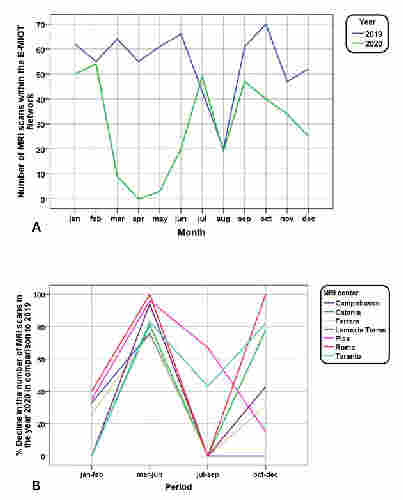
Contributions
Abstract: PB1602
Type: Publication Only
Session title: Iron metabolism, deficiency and overload
Background
The T2* magnetic resonance imaging (MRI) technique for the noninvasive quantification of iron overload has significantly improved the survival of patients with hemoglobinopathies by tailoring the chelation therapy. In Italy, the E-MIOT (Extension-Myocardial Iron Overload in Thalassemia) Network, a collaborative project among MRI and hematological centers, has assured high-quality quantification of iron in vital organs such as heart, liver, and pancreas. The COVID-19 pandemic has disrupted healthcare services around the world, also leading to postpone or delete deferable diagnostic evaluations.
Aims
We evaluated the impact of the COVID-19 pandemic on MRI services for iron overload quantification in Italy.
Methods
The activity of the MRI centers of the E-MIOT Network in the year 2020 was compared to the activity in the same months of 2019. A specific survey was filled out by the MRI operators to evaluate if the availability of MRI slots for patients with hemoglobinothies was reduced and the reasons.
Results
In comparison with the year 2019, in 2020 there was a significant reduction in the number of T2* MRIs performed (350 vs 656; P<0.0001). The comparison month by month between the two years highlighted a marked decline (86.9%) in the four-month period March-June 2020, a reduction in the gap between the two years in the three-month period July-September, and a new decline (41.4%) in the three-month period October-December (Figure 1A). No patient with hemoglobinopathy could undergo an MRI scan during the Italian lockdown (9 March-10 May 2020).
Figure 1B shows the percentage of decline (year 2020 vs 2019) in the number of T2*MRI scans for each MRI center. If no decline or an increase were present, the vertical axis was set at 0. All centers experienced a significant drop in the number of the T2* MRIs in the four-month period March-June (from 75 to 100%). In the three-month period July-September only the centers of Pisa and Taranto dropped the number of T2* MRIs due to the rescheduling of the other MRI appointments deleted during the lockdown. In the three-month period October-December a reduction of the T2* MRI scans was experienced by all centers, except for Campobasso. In the centers of Ferrara and Lamezia Terme the reduction was the consequence of the general reduction in the number of the total MRIs scheduled per day for the sanitation procedures. In the other centers, the availability for T2* MRI scans was unchanged in comparison to 2019, but the patients refused the MRI follow up for fear of getting sick of COVID.

Conclusion
The COVID-19 pandemic is having a strong negative impact on the quantification of iron overload by MRI, which may seriously worsen the prognosis of patients with hemoglobinopathies. Strategies to ensure proved lifesaving MRI exam and to reassure patients about the health safety of the hospitals are recommended.
Keyword(s): COVID-19, Iron overload, Magnetic resonance imaging
Abstract: PB1602
Type: Publication Only
Session title: Iron metabolism, deficiency and overload
Background
The T2* magnetic resonance imaging (MRI) technique for the noninvasive quantification of iron overload has significantly improved the survival of patients with hemoglobinopathies by tailoring the chelation therapy. In Italy, the E-MIOT (Extension-Myocardial Iron Overload in Thalassemia) Network, a collaborative project among MRI and hematological centers, has assured high-quality quantification of iron in vital organs such as heart, liver, and pancreas. The COVID-19 pandemic has disrupted healthcare services around the world, also leading to postpone or delete deferable diagnostic evaluations.
Aims
We evaluated the impact of the COVID-19 pandemic on MRI services for iron overload quantification in Italy.
Methods
The activity of the MRI centers of the E-MIOT Network in the year 2020 was compared to the activity in the same months of 2019. A specific survey was filled out by the MRI operators to evaluate if the availability of MRI slots for patients with hemoglobinothies was reduced and the reasons.
Results
In comparison with the year 2019, in 2020 there was a significant reduction in the number of T2* MRIs performed (350 vs 656; P<0.0001). The comparison month by month between the two years highlighted a marked decline (86.9%) in the four-month period March-June 2020, a reduction in the gap between the two years in the three-month period July-September, and a new decline (41.4%) in the three-month period October-December (Figure 1A). No patient with hemoglobinopathy could undergo an MRI scan during the Italian lockdown (9 March-10 May 2020).
Figure 1B shows the percentage of decline (year 2020 vs 2019) in the number of T2*MRI scans for each MRI center. If no decline or an increase were present, the vertical axis was set at 0. All centers experienced a significant drop in the number of the T2* MRIs in the four-month period March-June (from 75 to 100%). In the three-month period July-September only the centers of Pisa and Taranto dropped the number of T2* MRIs due to the rescheduling of the other MRI appointments deleted during the lockdown. In the three-month period October-December a reduction of the T2* MRI scans was experienced by all centers, except for Campobasso. In the centers of Ferrara and Lamezia Terme the reduction was the consequence of the general reduction in the number of the total MRIs scheduled per day for the sanitation procedures. In the other centers, the availability for T2* MRI scans was unchanged in comparison to 2019, but the patients refused the MRI follow up for fear of getting sick of COVID.

Conclusion
The COVID-19 pandemic is having a strong negative impact on the quantification of iron overload by MRI, which may seriously worsen the prognosis of patients with hemoglobinopathies. Strategies to ensure proved lifesaving MRI exam and to reassure patients about the health safety of the hospitals are recommended.
Keyword(s): COVID-19, Iron overload, Magnetic resonance imaging


